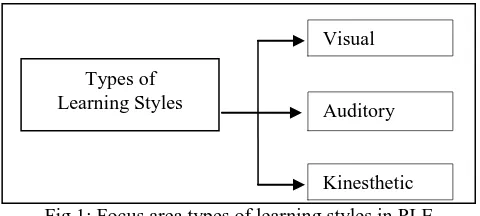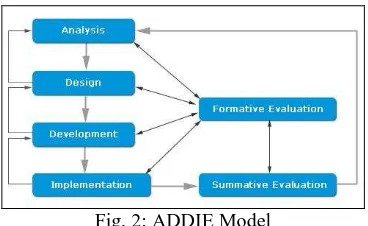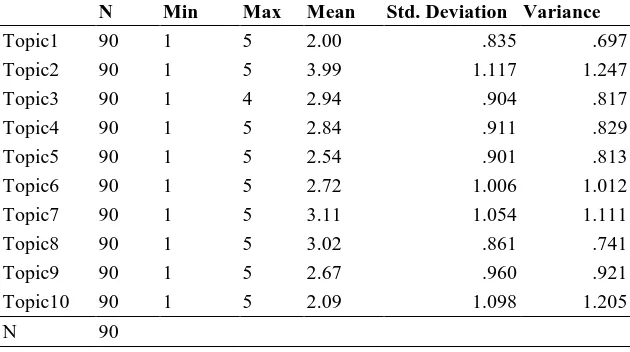Learning Approach for Personalized Learning
Environment (PLE): Preliminary Analysis
Che Ku Nuraini Che Ku Mohd & Faaizah Shahbodin
Department of Interactive Media, Faculty of Information andCommunication Technology,University of Technical Malaysia Melaka, Hang Tuah Jaya,76100 Durian Tunggal, Melaka,Malaysia.
[email protected],[email protected]
Abstract
This paper reports the preliminary analysis findings that aimed to investigate
student‟s learning styles that suitable for learning Form 2 Science subject using Personalized Learning Environment (PLE). An additional problem is that even learners from a similar learning context are not identical: they may be at different points of the learning process, or may have different learning styles. It will focus on the student perspective because they are so often ignored when it comes to the introduction of new technologies.With learners coming into schools, colleges and universities with increasingly smart technologies and schools and ministries of education, colleges and universities around the world beginning to add computer to the mix of technologies in schools. Learners expressed a desire for the integration of Science resources with their existing textbooks and online learning materials. It considers how they are using them and how this might differ from the suggested practice described in the literature and then considers what might be the implications for technology use in classrooms.
Keywords: computer, multimedia, science, PLE, technology
1.
Introduction
students‟ interests in science subjects is contributed by the students „perceptions
that, there is little relevance of science courses with their daily life.
The subject chosen in this study is Science Form 2. The Integrated Curriculum for Secondary Schools Specifications Science Form 2 is based on Ministry of Educations Malaysia. This project will propose new learning approach which is Personalized Learning Environment (PLE). Rather than the instructor, facilities, resources and tools PLE is more focused on individual learning. The effectiveness of learning can be improved through PLE where it plays active role [8]. In a network of people, services and resources PLE is one of the tools for a learner to be engaged in a distributed environment [13].
2.
Literature Review
In 21st century, personal learning educational approach really through flexibility and choice, respect, recognizing the unique gifts, skills, passions and qualities for children as a challenges and obstacles [7].PLE has also played an active role in improving the effectiveness of learning. Indeed, traditional learning based on
“one size fits all” approach, tends to support only one educational model,
because in a typical classroom situation, a teacher often has to deal with several students at the same time [4]. Many researchers [2;7;10;11;16;17] suggested that the differences and distinctiveness of each learners must be taken in preparing the learning procedures to make sure learners are engaged and take responsibility for their own learning. Besides that, learners always has control what they learn but learner may not have control over what is taught. Learning experience becomes one of the core issues in the personalization [5]. We use Google, peers communication, online communities, problem solving and share learning resources [5]. A lot of academic learning happens beyond the formal educational systems. PLE represents a paradigm shift [6]; an idea of learning that easy-to-use environment based on continuous and ongoing process that provided by number of resources and individuals. The tool is very important in order to support individual learner which takes place in many contexts and situations [1].
Fig.1: Focus area types of learning styles in PLE
There are three types of learning styles that applied in this study which is 1) Auditory, 2) Visual and 3) Kinesthetic.
i. Visual: Students prefer using pictures, images, and spatial
understanding. Learn by seeing. Frequently review notes, listen and take notes. They can hear well and sit in the lecture hall or classroom. After read something, summarize and recite it loudly.
ii. Auditory: Students prefer using sound and music. Learn by hearing. Frequently write everything and review visual quickly. They practice by visualization or picturing words/concepts in head. They also use flashcards, notes filmstrips, maps and charts,
iii. Kinesthetic: Students prefer using your body, hands and sense of touch. Learn by feeling or experiencing. Write several times for the facts that must be learned. Scratch paper is kept. Important thing is taking and taking and keeping lecture notes. Make study sheets.
To contribute to the successful of implementation on PLE are adopting applications, matching learning activities and integrating technologies in instruction. Thus, learning environment should be according to students learning styles, preferences and needs.
3.
Methodology
The methodology used to develop a courseware is ADDIE (Analyze, Design, Develop, Implement and Evaluate) model. ADDIE is a systematic or step by step model used for product development. Each phase to ensure development efforts stay on track, time and target. Figure 2 shows the ADDIE model adopted from http://www.cmcltd.com/sbu/cet_elearning.html.
Types of Learning Styles
Visual
Auditory
Fig. 2: ADDIE Model 3.1 Analysis phase
During analysis phase, the identification of student‟s problem in learning Science subject is defined. After that, goals and objectives are established and the PLE
environment and methodology were identified so that student‟s requirements for
assessment will achieve through this model. Focused group interviews, literature survey and survey will be conducted to verify requirement.
3.2 Design phase
Design a prototype based on the model proposed and concerned with the learning approach. Based on expected outcomes, produced from the above analysis, the interactive prototype can be designed by selecting content, media and type of interactivity that best underpins the objectives.
3.3 Development phase
The develop stage integrates PLE modules. At this point developing process initiates based on the storyboard created and concluded in an Alpha version of the product. By using the storyboard as guide, the development will start with interface development followed by the content. Each module will be built and ensure each button and function is working properly.
3.4 Implementation phase
This phase is to make sure the prototype is functional. All the modules and elements will be integrated to produce a final product that is ready to use. Demo application with a small group is very important to get the feedback that can be used to revise and improve the software.
3.5 Evaluation phase
This phase is the activities that require improvement for increasing the research result. Evaluation process is collecting feedbacks from end users. The questionnaire from the testers will be used for collecting feedback from the users of the software regarding the interface, PLE methodology, and its content.
4.
Preliminary Analysis
Table 1 shows the findings of preliminary analysis to find the difficult topic in Science Form 2 subject. Researcher conducts an interview with Science Form 2 teachers to find the most difficult topic. Nutrition is most difficult and also having many subtopics. The subtopics of Nutrition are Classes of Food, The Importance of a Balance Diet, Human Digestive System, Absorption of Digested Food, Reabsorption of Water and Defecation and Healthy Eating Habits.
Table 1: Preliminary analysis findings to find difficult topic in Science Form 2
N Min Max Mean Std. Deviation Variance
The data from the questionnaire are analyzed by using Statistical Package for the Social Science (SPSS). Few students have interviewed for the feedback regarding to the Nutrition topic. According to the feedback received, they have to remember the facts that had been taught in this topic. They also were boring with this topic. This boredom became more serious as students have not exposed on how improve the learning processes in this topic. Table 2 shows the frequencies for Topic 2 which is Nutrition in Science subject. 40% agree and 38.9% strongly agree that Nutrition is the hardest topic compared to other topics. Only 3.3% states that Nutrition is the easiest topic followed by easy which is 12.2%.
Table 2: Frequencies for Topic 2 Nutrition
Valid Frequency Percent Valid
Percent
internet for their study. Only 2.2% not agree and 1.1% strongly not agrees of using internet in their study. They also extremely value, useful tools which help them to plan their tasks, save time, simplify complicated tasks and definitively, have fun.
Table 3: Students Need Internet for Their Study
Frequency Percent Valid
Percent
Cumulative Percent
Strongly Agree 36 40.0 40.0 40.0
Agree 35 38.9 38.9 78.9
Middle 16 17.8 17.8 96.7
Not Agree 2 2.2 2.2 98.9
Strongly Not Agree 1 1.1 1.1 100.0
Total 90 100.0 100.0
This research will provide a model to identify and assess student‟s preferences dominant learning styles which are Visual, Auditory and Kinesthetic and it will be used to develop the system. The behavior and performance of the students will be measured. A framework and model will be develop and generated focusing on the cognitive skills towards PLE.
5.
Expected Results
This research will provide a new model and prototype for Form 2 Science students based on learning styles using PLE approach. Hence, the student performance in Science subject will increase. It also can be proposed a new model for Science subject for Form 2 students based on learning styles preferences.
6.
Conclusions
Preliminary analysis findings from this study seem to suggest that, perhaps not surprisingly, computers are being used in schools in similar ways to the other implementations of technology in the classroom. If we consider the possibilities for the use of PLE that are discussed in the literature, we need to work more on making sure that teachers receive effective training to understand what the potentials are of such technologies and the powers that be need to make sure that access to the Internet makes this kind of activity possible.
Acknowledgements
Corresponding Author
Author 1 is Che Ku Nuraini Che Ku Mohd, PhD. student attached at Universiti Teknikal Malaysia Melaka (UTeM), Melaka, Malaysia. She received her Degree in Computer Science (Interactive Media) in 2008 and Master of Science in Information and Communication Technology (Multimedia) in 2011. Her current research is related to User Interface Design, Human Computer Interaction and Personalized Learning Environment (PLE). Email: [email protected], mobile +0129082650.
Author 2 is Faaizah Shahbodin cum main supervisor for author 1. She received her Degree in Computer Science in 1994 from Universiti Utara Malaysia (UUM), and Master in Computer Science in 1997 from Queensland University of Technology (QUT), Brisbane, Australia. She was a researcher, and a project supervisor for several computers in education projects in UNIMAS, Kolej Latihan Telekom (Kolej Multimedia), and UTeM for 15 years. She completed her Ph.D in Multimedia Education Systems at University Kebangsaan Malaysia (UKM). Her research interests are primarily on Problem Based Learning, Multimedia Applications, Creative Contents and User Interface Design. Email: [email protected] , mobile +0196585704.
References
[1] Alkhasaweh, I. M., Mrayyan, M. T., Docherty, C, Alashram, S., & Yosef, H. Problem-based learning (PBL): Assessing students' learning preferences using VARK. Nurse Education Today, 28, 572-579,2008.
[2] Aviram A, Ronen Y, Somekh S, Winer A, Sarid A Self-Regulated Personalized Learning (SRPL): Developing iClass’s pedagogical model. eLearn. Papers, 9: 1-17, 2008.
[3] Attwell, G. Personal Learning Environments: The future of education, SlideCast. Available at: http://www.pontydysgu.org/2009/01/personal-learning-environments-the-slidecast/2009.
[4] Bachari E., El Hassan Abelwahed and Mohammed El Adnani (2011).
E-Learning Personalization Based On Dynamic Learners’ Preference.
International Journal of Computer Science & Information Technology (IJCSIT), Vol 3, No 3, June 2011.
[5] Chatti, M. A., Agustiawan, M. R., Jarke, M., Specht, M. Toward a Personal Learning Environment Framework. International Journal of Virtual and Personal Learning Environment 1(4): 66 – 85,2010.
[6] Elliott, C. We are not alone: the power of Personal Learning Networ ks, in Synergy, 7(1), 47 – 50, 2010.
[7] Ertl, B., Ebner, K., and Kikis-Papadakis, K. "Evaluation of eLearning," International Journal of Knowledge Society Research (IJKSR), 1, 3 (2010), 31-43,2010.
[9] Gu X. and Li X. A Conceptual Model of Personal Learning Environment Based On Shanghai Lifelong Learning System. Proceedings of the 17th International Conference on Computers in Education [CDROM]. Hong Kong: Asia-Pacific Society for Computers in Education, 885, 2009.
[10]Goodrum, D., Hackling, M. and Rennie, L. The status and quality of teaching and learning of science in Australian schools: A research report. Canberra: Department of Education, Training and Youth Affairs.2001. [11]Minocha, S., Schroeder, A. and Schneider, C. Role of the educator in social
software initiatives in further and higher education: A conceptualization and research agenda. British Journal of Educational Technology, 42: no. doi: 10.1111/j.1467-8535.2010.01131. 2011.
[12]Retalis S, Paraskeva F, Tzanavari A, Garzotto F.Learning Styles and Instructional Design as Inputs for Adaptive Educational Hypermedia Material Design. Paper presented at the "Information and Communication Technologies in Education" - Fourth Hellenic Conference with International Participation, Athens, Greece.2004.
[13]Samah A.N.,Yahaya N. and Ali M.B. Individual differences in online personalized learning environment. Educational Research and Reviews Vol. 6 (7), pp. 516-521, July 2011. Available online at http://www.academicjournals.org/ERRISSN 1990-3839 ©2011 Academic Journals, 2011.
[14]S.bDownes. Learning Networks and Connective Knowledge.Discussion Paper. Instructional Technology Forum, 2006. Available at: http://it.coe.uga.edu/itforum/paper92/paper92.html. 2006.
[15]Speering, W. and Rennie, L. Students’ Perceptions about Science. The Impact of Transition from Primary to Secondary Schools. Retrieved from http:// research.acer.edu.au.aer/3.1996)
[16]Thomson, S. and Fleming, N. Examining the Evidence: Science Achievement in Australia Schools. Retrieved from http://research.acer.edu.au/aer/3.2004. [17]Trinidad S. Working with Technology-rich Learning Environments:



